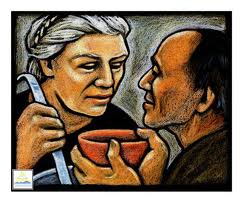Mark 16:1-8
For the past month, I’ve been working via a temp agency at a non-profit in Falls Church. We were at a staff meeting recently when the boss asked me why I hadn’t finished some work he had assigned to me.
“I don’t have all the information,” I said. “If I had the information, I could do the job.”
The boss looked at me and said, in some exasperation – for he did not have the information either, “Well, why don’t you just give me eternal life while you’re at it!”
Immediately, I shot back at him: “I can do that! I’m a priest! It’s a done deal! You already have eternal life! Now can I have my information?!”
My boss’ reaction to this was … well, it was a bit startled. In the month I worked there, he kept forgetting that I’m a priest, and that proclaiming the Gospel is a more important to me than anything else. He kind of laughed off my remark, and meeting went on from there, but I couldn’t help feeling that his remark is emblemic of the challenge that we face as disciples of Jesus these days.
For us, the Resurrection – the triumph of God’s life over mortal death – is a done deal. Happened 2,000 years ago, outside the gates to Jerusalem, on a Sunday morning. Been there, done that, got the T-shirt to boot.
But for so many, the Good News of God’s love is not a fact around which they center their lives.
For so many, it is … well, it’s a special brunch on a Sunday morning. Or an Easter Egg Hunt. Or a chocolate bunny.
You can’t really blame people for not knowing this Good News, for reducing it to off-hand comments like my boss, for making it seem impossible …
Not when you read Mark’s Gospel, you can’t.
Because Mark’s Gospel ends in such a way that it’s amazing anyone knows the Good News of God in Christ Jesus.
Really.
Listen to it again:
So they (the women) went out and fled from the tomb, for terror and amazement had seized them; and they said nothing to anyone, for they were afraid.
You may not realize it, but this verse is considered the true ending of Mark’s Gospel. That’s it: The women left and said nothing to anything, for they were afraid.
No actual resurrection moment.
No Mary Magdalene going to the others to say, “He is risen!”
No disbelieving disciples.
No other appearances, not to the 11, not to the two walking along the road.
No charge to “go into all the world and preach the Gospel to all creation.”
Nothing.
For they were afraid.
How many of us are as afraid as the women to proclaim the Good News?
How often do we, who gather joyfully on Easter morning to celebrate, to say “Alleluia!” again, go out into the world and actually use that word?
How many of us are willing to overcome our fear and tell the truth, God’s truth?
The ending of Mark’s Gospel – the true ending, not what has been added on later – is as abrupt as its beginning. In his beginning, Mark doesn’t present a long genealogy like Matthew, he doesn’t tell a sweet story of the birth in the stable like Luke, he doesn’t engage in theological discussions like John.
Mark simply and brutally lays out the truth:
The beginning of the Good News of Jesus Christ, the Son of God.
Short and sweet and to the point. Just the facts, ma’am, thank you very much.
The ending is the same: He has been raised; he is not here. … And they said nothing to anyone, for they were afraid. Short and sweet and to the point. Just the facts, ma’am, thank you very much.
And if you think about it, wouldn’t you have been afraid, if you had been the first ones to go to the tomb, filled with grief, because the man you’ve followed for so long, the man you’ve seen done miracles, the man who preached a truth such as the world had never heard, if that man were dead, crucified by the cruel Romans in the cruelest way possible, in a way that in your own tradition was nothing less than total humiliation?
Wouldn’t you have been afraid, if when you arrived at that tomb, you discovered it was … empty? And that some young man … a man you do not know, whom you have never seen before … was sitting there, clothed in a white robe, telling you that Jesus was gone, that he had been resurrected (“What?” you think. “What does he mean, ‘resurrected’?), and that you are to go tell this improbable, this impossible so-called “truth” to the rest of the disciples?
Wouldn’t you have been, like those three women, scared to death?
And wouldn’t you, like those three women, have kept your mouth shut?
Well, thankfully, the women did not keep their mouths shut, nor did the disciples, because obviously someone girded up their loins and told the truth, God’s truth, and the world soon knew … with astonishing speed, if you think about it … that Alleluia! Christ is risen! The Lord is risen indeed! Alleluia!
Because – think about it – if no one had told the truth, God’s truth, we wouldn’t be here today, would we?
But that still leaves us with the question, on this Easter morning, of whether we are afraid, in this day and age, to tell that truth, God’s truth, ourselves.
Commentator David Lose believes that Mark intentionally ended the Gospel as abruptly as he began it “precisely to place the burden of responsibility for telling the Good News squarely on our shoulders. … By ending his account in this way, [Mark] invites us into the story, to pick up where these women left off and, indeed, go and tell the Jesus of Nazareth, who was crucified, has been raised, and is going ahead to meet us, just as promised.”[1]
In other words, no matter how afraid we might be, it is our job to tell this story, to finish it. It is our job to tell people, like that boss of mine at the non-profit, the meaning of Easter.
It is our job, my friends, to set aside our fear so that we can stand up for Jesus.
• • •
I remember the first time I tried to proclaim the Gospel, tried to tell the story of Jesus. I was a child in Catholic elementary school – I was probably in fourth or fifth grade at the time – and I, the little Roman Catholic who had cut my teeth on doctrine, tried to tell my little Protestant friends about Jesus. The problem was, I had cut my teeth on doctrine, and that’s about all I could proclaim, whereas my little Protestant friends had cut their teeth on the Bible and actually knew the story of Jesus. I can tell you, it was a good long time before I tried proclaiming the truth of God’s love in the Risen Lord!
So I know what it’s like to be afraid … I know what it’s like to be like those three women who went to the tomb very early on the first day of the week, and to be confronted with a truth bigger than I could handle.
Now, as you all know well, you can’t keep me from proclaiming the Gospel!
So … on this Easter morning, I am asking each of us to dig down and think hard and long:
What are we afraid of?
What is it that keeps us from proclaiming the truth, God’s truth, to the whole wide world?
If we can’t speak the words – He is risen! – in public, then can we at least live those words with our lives?
Can we do what St. Francis is purported to have said, to “preach the Gospel always, and if necessary, use words”?
Because, I can assure you, there’s nothing to be afraid of.
Because I can assure you, this is true: Christ is risen.
So let’s get to it.
Let us set aside whatever it is that scares us, let us stand up for Jesus, and let us proclaim that truth, God’s truth, to the whole wide world:
Alleluia! Christ is risen! The Lord is risen indeed! Alleluia!
Amen.
Sermon preached on Easter morning, Year B, at Church of the Good Shepherd, Blue Grass, Va., 8 April 2012.
[1] David Lose, Marbury E. Anderson Biblical Preaching Chair, Luther Seminary, St. Paul, MN, “Just the beginning,” on workingpreacher.org, http://www.workingpreacher.org/dear_wp.aspx?article_id=574, posted 1 April 2012.

















